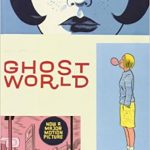Even for English professor, David Brauner, who teaches about the graphic novel, compiling an all-time top five list is challenging. It’s not just the way that such a list is compiled, making agonising decisions over which favourites to exclude, but also because it raises tricky questions of definition. That the term refers not just to fiction but to life-writing, as in all manner of memoirs, diaries and so on, is accepted – but beyond that there is little consensus. Here he chooses five books that he regards as central to the graphic novel canon – that are both immediately arresting and also reward repeated re-reading.

If there are multiple volumes (as with Neil Gaiman’s The Sandman or the Hernandez brothers’ Love and Rockets series), should the whole series be counted as one epic graphic novel, or should only individual volumes be eligible?
And what about a book like Phoebe Gloeckner’s The Diary of a Teenage Girl(2002), which tells the story of an authorial alter-ego, Minnie, through a combination of prose diary entries, illustrations with captions, comic-strip narratives, letters, poems and photographs? Or Joe Sacco’s comic-strip documentary journalism?
I’ve chosen five books that I (and many others) regard as central to the graphic novel canon. They are all richly textured, powerful, nuanced books that are immediately arresting but also reward repeated re-reading.
1. Watchmen (1987)

’ Watchmen works on so many levels – it is, among other things, a whodunnit, a love story, a commentary on Cold War politics and an exploration of fundamental philosophical and ethical questions.
Shifting points of view, disrupting chronology, layering texts within texts, Watchmen is a hugely ambitious narrative that discloses new details with every fresh reading. It’s also a real page-turner.
2. Maus (1991)
Art Spiegelman’s masterpiece, Maus, probably did more than any other graphic novel to make readers and critics take this genre seriously.

It’s the story of the author’s father, Vladek, who survived Auschwitz, as well as the story of Spiegelman’s relationship with him. Controversially representing Jews as anthropomorphised mice, preyed upon by German cat-people and often betrayed by Polish pig-people, Maus nevertheless resists stereotypes. The novel represents both its author and his father as flawed, complex individuals who struggle in different ways to deal with the legacy of a trauma that makes itself felt in every aspect of their lives.
3. Ghost World (1997)
Daniel Clowes’ Ghost World is the shortest – and at first glance the most straightforward – of my choices. It’s a bittersweet tale of the friendship, and gradual estrangement, of recent high-school graduates Enid and Becky.

Cynical and vulnerable, with a sardonic sense of humour and a nostalgic streak, Enid is, in part, a portrait of the artist as a young girl, grapping with her sexuality, ethnicity and her conflicting expectations of herself.
But Ghost World is also a powerful evocation of what it is like to drift, ghost-like, through a nondescript, soulless urban environment that is itself ghostly. Full of quirky characters and memorable images, Ghost World manages, paradoxically, to represent boredom and ennui vividly and entertainingly.
4. Jimmy Corrigan, the Smartest Kid on Earth (2000)
Chris Ware’s Jimmy Corrigan was the first graphic novel to be awarded major literary prizes on both sides of the Atlantic – the American Book Award and The Guardian First Book Award.

Like Watchmen, Jimmy Corrigan has a complex, non-linear structure and subverts conventional notions of (super)heroism. Like Maus, it is a book about fathers and sons; and like Ghost World, it has a protagonist who is drifting aimlessly through life, alienated from the world around him.
Yet it is visually and formally more radical than any of the other books on this list. Chris Ware’s dark palette and landscape format and his use of diagrams, instructions and definitions make the book, as an object and text, highly unusual. In terms of narrative, too, Ware is a great innovator – the absence of exposition and page numbering, the abrupt transitions between a historical narrative focusing on Jimmy’s grandfather and the present-day narrative focusing on Jimmy, the use of surreal dream sequences and the disruption of conventional panel sequencing all make Jimmy Corrigan challenging.
But it’s well worth the effort. It is a beautiful, heartbreaking story that has been much imitated but never bettered.
5. Fun Home (2006)
Alison Bechdel’s Fun Home is a self-consciously literary coming of age novel that pays homage to James Joyce, Marcel Proust and Oscar Wilde, among others.

It is a moving memoir about the author’s relationship with her father, whose queer sexuality finds an echo in her lesbianism, and whose (possible) suicide haunts the book.
Adapted as an award-winning musical, Fun Home reached an audience that might never have encountered the bestselling graphic novel. Yet while Fun Home the musical is fun, just like the film adaptations of Watchmen and Ghost World, it can’t quite do justice to the complexity of the original.
What I hope a reading of these titles will demonstrate to any newcomers is that these are not just great graphic novels but great works of art. The term graphic novel was initially deployed in order to confer intellectual credibility on what had been previously seen as a trivial form of entertainment aimed primarily at children. But the works listed above rival anything done in the novel form over the same period – some of the most innovative and exciting work in fiction and life-writing is being done right now in the graphic novel form.
David Brauner is Professor of Contemporary Literature in the Department of English Literature, University of Reading
This article is republished from The Conversation under a Creative Commons license. Read the original article.
